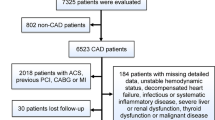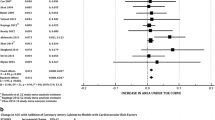Abstract
High-sensitivity C-reactive protein (CRP), a nonspecific marker of inflammation, is a newly available biomarker for predicting the risk of cardiovascular events. CRP has been shown to predict risk of cardiovascular events independent of traditional risk factors and in the setting of low levels of low-density lipoprotein cholesterol. Statins have been shown to decrease CRP, and studies are now under way to evaluate if targeting patients with high CRP and low low-density lipoprotein cholesterol will have any impact on future cardiovascular events and survival and whether changes in CRP correlate to event reduction. The utility of CRP as a target of therapy remains to be proved, and these ongoing studies will likely provide us with guidance.
Similar content being viewed by others
References and Recommended Reading
Braunwald E: Shattuck lecture—cardiovascular medicine at the turn of the millennium: triumphs, concerns, and opportunities. N Engl J Med 1997, 337:1360–1369.
Pepys MB, Baltz ML: Acute phase proteins with special reference to C-reactive protein and related proteins (pentaxins) and serum amyloid A protein. Adv Immunol 1983, 34:141–212.
Kuller LH, Tracy RP, Shaten J, Meilahn EN: Relation of C-reactive protein and coronary heart disease in the MRFIT nested case-control study. Am J Epidemiol 1996, 144:537–547.
Koenig W, Sund M, Frohlich M, et al.: C-reactive protein, a sensitive marker of inflammation, predicts future risk of coronary heart disease in initially healthy middle-aged men: results from the MONICA (Monitoring Trends and Determinants in Cardiovascular Disease) Augsburg Cohort Study, 1984 to 1992. Circulation 1999, 99:237–242.
Ridker PM, Hennekens CH, Buring JE, Rifai N: C-reactive protein and other markers of inflammation in the prediction of cardiovascular disease in women. N Engl J Med 2000, 342:836–843.
Folsom AR, Aleksic N, Catellier D, et al.: C-reactive protein and incident coronary heart disease in the Atherosclerosis Risk in Communities (ARIC) study. Am Heart J 2002, 144:233–238.
Ballantyne CM, Hoogeveen RC, Bang H, et al.: Lipoprotein-associated phospholipase A2, high-sensitivity C-reactive protein, and risk for incident coronary heart disease in middle-aged men and women in the Atherosclerosis Risk in Communities (ARIC) Study. Circulation 2004, 109:837–842.
Rost NS, Wolf PA, Kase CS, et al.: Plasma concentration of C-reactive protein and risk of ischemic stroke and transient ischemic attack: the Framingham study. Stroke 2001, 32:2575–2579.
Ross R: Atherosclerosis—an inflammatory disease. N Engl J Med 1999, 340:115–126.
Libby P, Ridker PM: Novel inflammatory markers of coronary risk. Circulation 1999, 100:1148–1150.
Plutzky J: Inflammatory pathways in atherosclerosis and acute coronary syndromes. Am J Cardiol 2001, 88:10K-15K.
Torzewski M, Rist C, Mortensen RF, et al.: C-reactive protein in the arterial intima: role of C-reactive protein receptor-dependent monocyte recruitment in atherogenesis. Arterioscler Thromb Vasc Biol 2000, 20:2094–2099.
Pasceri V, Willerson JT, Yeh ET: Direct proinflammatory effect of C-reactive protein on human endothelial cells. Circulation 2000, 102:2165–2168.
Zwaka TP, Hombach V, Torzewski J: C-reactive protein-mediated low density lipoprotein uptake by macrophages: implications for atherosclerosis. Circulation 2001, 103:1194–1197.
Verma S, Wang CH, Li SH, et al.: A self-fulfilling prophecy: C-reactive protein attenuates nitric oxide production and inhibits angiogenesis. Circulation 2002, 106:913–919.
Venugopal SK, Devaraj S, Yuhanna I, et al.: Demonstration that C-reactive protein decreases eNOS expression and bioactivity in human aortic endothelial cells. Circulation 2002, 106:1439–1441.
Devaraj S, Xu DY, Jialal I: C-reactive protein increases plasminogen activator inhibitor-1 expression and activity in human aortic endothelial cells: implications for the metabolic syndrome and atherothrombosis. Circulation 2003, 107:398–404.
Danenberg HD, Szalai AJ, Swaminathan RV, et al.: Increased thrombosis after arterial injury in human C-reactive protein-transgenic mice. Circulation 2003, 108:512–515.
Yeh ET: CRP as a mediator of disease. Circulation 2004, 109:II-11–II-14.
Pasceri V, Chang JS, Willerson JT, Yeh ET: Modulation of C-reactive protein-mediated monocyte chemoattractant protein-1 induction in human endothelial cells by antiatherosclerosis drugs. Circulation 2001, 103:2531–2534.
Lindahl B, Toss H, Siegbahn A, et al.: Markers of myocardial damage and inflammation in relation to long-term mortality in unstable coronary artery disease. N Engl J Med 2000, 343:1139–1147.
Zebrack JS, Anderson JL, Maycock CA, et al.: Usefulness of high-sensitivity C-reactive protein in predicting long-term risk of death or acute myocardial infarction in patients with unstable or stable angina pectoris or acute myocardial infarction. Am J Cardiol 2002, 89:145–149.
West of Scotland Coronary Prevention Study Group: Influence of pravastatin and plasma lipids on clinical events in the West of Scotland Coronary Prevention Study (WOSCOPS). Circulation 1998, 97:1440–1445.
McCarey DW, McInnes IB, Madhok R, et al.: Trial of Atorvastatin in Rheumatoid Arthritis (TARA): double-blind, randomised placebo-controlled trial. Lancet 2004, 363:2015–2021.
Weber C, Erl W, Weber KS, Weber PC: HMG-CoA reductase inhibitors decrease CD11b expression and CD11b-dependent adhesion of monocytes to endothelium and reduce increased adhesiveness of monocytes isolated from patients with hypercholesterolemia. J Am Coll Cardiol 1997, 30:1212–1217.
Kimura M, Kurose I, Russell J, Granger DN: Effects of fluvastatin on leukocyte-endothelial cell adhesion in hypercholesterolemic rats. Arterioscler Thromb Vasc Biol 1997, 17:1521–1526.
Rasmussen LM, Hansen PR, Nabipour MT, et al.: Diverse effects of inhibition of 3-hydroxy-3-methylglutaryl-CoA reductase on the expression of VCAM-1 and E-selectin in endothelial cells. Biochem J 2001, 360:363–370.
Rosenson RS, Tangney CC, Casey LC: Inhibition of proinflammatory cytokine production by pravastatin. Lancet 1999, 353:983–984.
Chung HK, Lee IK, Kang H, et al.: Statin inhibits interferon-gamma-induced expression of intercellular adhesion molecule-1 (ICAM-1) in vascular endothelial and smooth muscle cells. Exp Mol Med 2002, 34:451–461.
Romano M, Diomede L, Sironi M, et al.: Inhibition of monocyte chemotactic protein-1 synthesis by statins. Lab Invest 2000, 80:1095–1100.
Martínez-González J, Alfón J, Berrozpe M, Badimon L: HMG-CoA reductase inhibitors reduce vascular monocyte chemotactic protein-1 expression in early lesions from hypercholesterolemic swine independently of their effect on plasma cholesterol levels. Atherosclerosis 2001, 159:27–33.
Bellosta S, Via D, Canavesi M, et al.: HMG-CoA reductase inhibitors reduce MMP-9 secretion by macrophages. Arterioscler Thromb Vasc Biol 1998, 18:1671–1678.
Ikeda U, Shimpo M, Ohki R, et al.: Fluvastatin inhibits matrix metalloproteinase-1 expression in human vascular endothelial cells. Hypertension 2000, 36:325–329.
Aikawa M, Rabkin E, Okada Y, et al.: Lipid lowering by diet reduces matrix metalloproteinase activity and increases collagen content of rabbit atheroma: a potential mechanism of lesion stabilization. Circulation 1998, 97:2433–2444.
Aikawa M, Rabkin E, Voglic SJ, et al.: Lipid lowering promotes accumulation of mature smooth muscle cells expressing smooth muscle myosin heavy chain isoforms in rabbit atheroma. Circ Res 1998, 83:1015–1026.
Hernández-Presa MA, Ortego M, Tuzón J, et al.: Simvastatin reduces NF-kB activity in peripheral mononuclear and in plaque cells of rabbit atheroma more markedly than lipid lowering diet. Cardiovasc Res 2003, 57:168–177.
Dichtl W, Dulak J, Frick M, et al.: HMG-CoA reductase inhibitors regulate inflammatory transcription factors in human endothelial and vascular smooth muscle cells. Arterioscler Thromb Vasc Biol 2003, 23:58–63.
Martin G, Duez H, Blanquart C, et al.: Statin-induced inhibition of the Rho-signaling pathway activates PPAR_ and induces HDL apoA-I. J Clin Invest 2001, 107:1423–1432.
Inoue I, Itoh F, Aoyagi S, et al.: Fibrate and statin synergistically increase the transcriptional activities of PPAR_/RXR_ and decrease the transactivation of NFkB. Biochem Biophys Res Commun 2002, 290:131–139.
Laufs U, La Fata V, Plutzky J, Liao JK: Upregulation of endothelial nitric oxide synthase by HMG CoA reductase inhibitors. Circulation 1998, 97:1129–1135.
Sparrow CP, Burton CA, Hemandez M, et al.: Simvastatin has anti-inflammatory and antiatherosclerotic activities independent of plasma cholesterol lowering. Arterioscler Thromb Vasc Biol 2001, 21:115–121.
Ridker PM, Rifai N, Pfeffer MA, et al., for the Cholesterol and Recurrent Events (CARE) Investigators: Inflammation, pravastatin, and the risk of coronary events after myocardial infarction in patients with average cholesterol levels. Circulation 1998, 98:839–844.
Ridker PM, Rifai N, Pfeffer MA, et al., for the Cholesterol and Recurrent Events (CARE) Investigators: Long-term effects of pravastatin on plasma concentration of C-reactive protein. Circulation 1999, 100:230–235.
Kinlay S, Schwartz GG, Olsson AG, et al., for the Myocardial Ischemia Reduction with Aggressive Cholesterol Lowering (MIRACL) Study Investigators: High-dose atorvastatin enhances the decline in inflammatory markers in patients with acute coronary syndromes in the MIRACL study. Circulation 2003, 108:1560–1566.
Ridker PM, Rifai N, Clearfield M, et al., for the Air Force/Texas Coronary Atherosclerosis Prevention Study Investigators: Measurement of C-reactive protein for the targeting of statin therapy in the primary prevention of acute coronary events. N Engl J Med 2001, 344:1959–1965.
Albert MA, Danielson E, Rifai N, Ridker PM, for the PRINCE Investigators: Effect of statin therapy on C-reactive protein levels: the Pravastatin Inflammation/CRP Evaluation (PRINCE): a randomized trial and cohort study. JAMA 2001, 286:64–70.
Balk EM, Lau J, Goudas LC, et al.: Effects of statins on nonlipid serum markers associated with cardiovascular disease: a systematic review. Ann Intern Med 2003, 139:670–682.
Ballantyne CM, Houri J, Notarbartolo A, et al., for the Ezetimibe Study Group: Effect of ezetimibe coadministered with atorvastatin in 628 patients with primary hypercholesterolemia: a prospective, randomized, double-blind trial. Circulation 2003, 107:2409–2415.
Betteridge J, Gibson M, on behalf of the ANDROMEDA study investigators: Effects of rosuvastatin and atorvastatin on LDL-C and CRP levels in patients with type 2 diabetes: results of the ANDROMEDA study. Presented at European Atherosclerosis Society, Seville, Spain. April 17–20, 2004,
Jialal I, Stein D, Balis D, et al.: Effect of hydroxymethyl glutaryl coenzyme a reductase inhibitor therapy on high sensitive C-reactive protein levels. Circulation 2001, 103:1933–1935.
Nissen SE, Tuzcu EM, Schoenhagen P, et al., for the REVERSAL Investigators: Effect of intensive compared with moderate lipid-lowering therapy on progression of coronary atherosclerosis: a randomized controlled trial. JAMA 2004, 291:1071–1080.
Cannon CP, Braunwald E, McCabe CH, et al., for the Pravastatin or Atorvastatin Evaluation and Infection Therapy-Thrombolysis in Myocardial Infarction 22 Investigators: Comparison of intensive and moderate lipid lowering with statins after acute coronary syndromes. N Engl J Med 2004, 350:1495–1504.
van Wissen S, Trip MD, Smilde TJ, et al.: Differential hs-CRP reduction in patients with familial hypercholesterolemia treated with aggressive or conventional statin therapy. Atherosclerosis 2002, 165:361–366.
Taylor AJ, Kent SM, Flaherty PJ, et al.: ARBITER: Arterial Biology for the Investigation of the Treatment Effects of Reducing Cholesterol: a randomized trial comparing the effects of atorvastatin and pravastatin on carotid intima medial thickness. Circulation 2002, 106:2055–2060.
Ridker PM, on behalf of the JUPITER Study Group: Rosuvastatin in the primary prevention of cardiovascular disease among patients with low levels of low-density lipoprotein cholesterol and elevated high-sensitivity C-reactive protein: rationale and design of the JUPITER trial. Circulation 2003, 108:2292–2297.
Expert Panel on Detection, Evaluation, and Treatment of High Blood Cholesterol in Adults: Executive summary of the third report of the National Cholesterol Education Program (NCEP) Expert Panel on Detection, Evaluation, and Treatment of High Blood Cholesterol in Adults (Adult Treatment Panel III). JAMA 2001, 285:2486–2497.
Pearson TA, Mensah GA, Alexander RW, et al.: Markers of inflammation and cardiovascular disease: application to clinical and public health practice: a statement for healthcare professionals from the Centers for Disease Control and Prevention and the American Heart Association. Circulation 2003, 107:499–511.
Author information
Authors and Affiliations
Rights and permissions
About this article
Cite this article
Nambi, V., Ballantyne, C.M. Utility of statin therapy using high-sensitivity C-reactive protein as an indicator of coronary heart disease risk. Curr Atheroscler Rep 7, 22–28 (2005). https://doi.org/10.1007/s11883-005-0071-8
Issue Date:
DOI: https://doi.org/10.1007/s11883-005-0071-8




